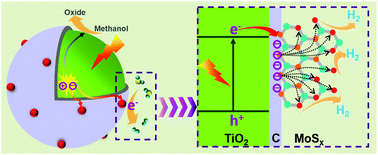Highly dispersed MoSx nanodot-modified TiO2 photocatalysts: vitamin C-mediated synthesis and improved H2 evolution activity†
Abstract
Unsaturated S atoms on exposed edges of MoS2 are demonstrated to be critical H2-generation active sites, and the strategy to fabricate a MoSx cocatalyst with a small size is promising in exposing more unsaturated S atoms to enhance its H2-evolution performance. In this article, highly dispersed MoSx nanodots with an ultrasmall size of ca. 1 nm are evenly loaded on the TiO2 surface via a thin-layered carbon supporter by applying a vitamin C-mediated method. Herein, vitamin C not only functions as an effective modifier to suppress the aggregation of MoSx nanodots for more exposed unsaturated S atoms to promote the interfacial H+-reduction reaction, but also works as a suitable precursor for the formation of a thin-layered carbon supporter for the MoSx nanodots and the host TiO2 to modify their interfacial coupling. The photocatalytic results show that the fabricated TiO2@C/MoSx (0.7 wt%) photocatalyst attains the highest H2-evolution rate of 971.4 μmol h−1 g−1, which is about two times higher than that of the TiO2/MoSx owing to the perfect synergistic effect of the thin-layered carbon for efficient photoelectron transfer and the ultrasmall MoSx nanodots for accelerated interfacial H2-evolution reaction. The present strategy, using a mediator for the simultaneous realization of the nanosized cocatalyst and improved cocatalyst-host interaction, could provide alternative idea for the further enhancement of photocatalytic H2-generation activity.



 Please wait while we load your content...
Please wait while we load your content...